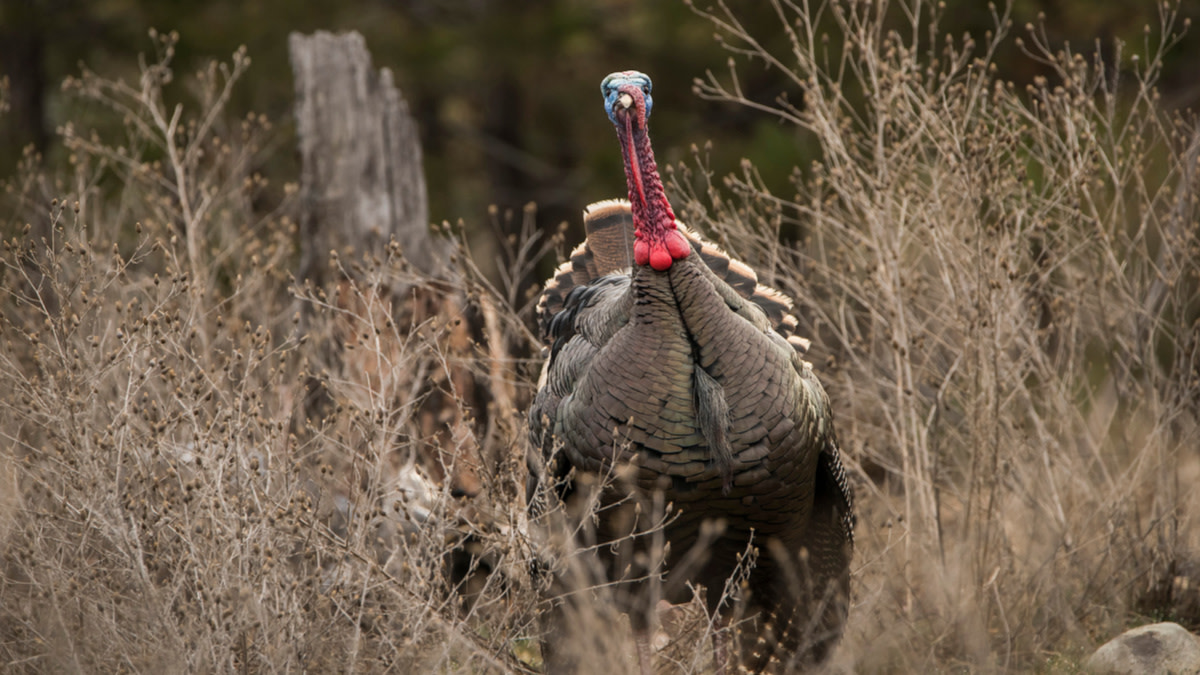
Preseason scouting is the best way to locate a gobbler. You wouldn’t walk into the woods the first morning of deer season and expect to be successful, so don’t do it with turkeys. You’ll have no idea whether the area has a healthy population of turkeys. Time spent scouting will give you knowledge and options.
Make note of particular turkey sign. Roost trees, feeding areas and travel routes will have scattered sign in the form of feathers, scat and tracks. These scouting trips can be accomplished by driving gravel roads in the evening or backpacking and camping trips in promising turkey country. Binoculars and a shock gobble inducer are a great start for finding birds.
If you do come across turkeys but are only seeing hens, you’re still in luck. If it’s breeding season, or close to, you can rest assured that toms will be in the area.
Hear the Turkey
Turkeys aren’t the easiest animals to visually spot at times. Using your ears to lock in on a gobbler is often the best route. I hope you like early mornings, because this is when toms sound off the most. It’s ideal to be in the woods a couple hours before daylight to sneak in under the cover of darkness and listen to toms on the roost. You’ll also hear toms gobbling in the late afternoon as the sun starts to slip through the sky.
Roosting areas are ideal places to focus your listening efforts. A key point here is to position yourself where you’re most likely to hear the gobbles from a safe distance. Move away from the roads, running creeks and streams or wind tunnels. Find the quiet zones on hilltops, ridges or edge habitat that maximize the listening area.
The Shock Gobble
As mentioned before, the shock gobble is a successful tactic if you’re trying to pinpoint a gobbler. There isn’t a great scientific explanation for the shock gobble, but you can rest assured that it works.
So, what the hell is a shock gobble? In the spring, male turkeys will often gobble at loud noises they encounter. Most any loud and abrupt noise that cuts the silence will cause a tom or jake to react like they’ve been hit with an electric cattle prod, with the reaction of an immediate “shock” gobble.
Hunters use a variety of tactics to produce a shock gobble and nature produces them as well. Sounds from coyotes, crows, hawks and owls work well. The flip side is the amount of unnatural noises that will cause a gobbler to respond. Natural sounds work well early in the morning, and unnatural calls are often good for evening roost location efforts. Make your calls short when using a shock gobble. Turkeys tend to respond immediately and you’ll miss the acoustic cue if a response happens during a longer call.
The crow call is the call of choice for a number of turkey hunters trying for the shock gobble. Crows are common in the wild turkey’s range. This loud noise will not initiate alarm, as the crow call is not foreign to turkeys. When utilizing a crow call, make a sharp noise that finishes cleanly. Make two or three calls and listen for the responding gobble. Just don’t overdo it.
See the Turkey
Sometimes visual cues are all you’ll get in the turkey woods. It pays to consistently scan for turkeys, especially with the help of binoculars. Wily toms are known for going mute, whether it be from close calls with other hunters or the presence of a predator.
Utilizing binoculars to find turkeys is ideal for time spent on overlooks. Another key location for glassing birds is where you can watch field edges or multiple travel routes from a single observation point. Glassing before traveling on foot is recommended. Study the edges and other turkey terrain before traipsing about.
Close the Distance
When a tom is spotted, you can use the same hunting efforts as if you’ve shock-gobble located him. Once you’ve located a gobbler, it’s time to close the distance. This is a delicate process, as the turkey’s eyesight has been known to bust hunters just for blinking.
In these circumstances, use the terrain to your advantage if possible. Timber helps conceal your movement and lower the chances of the spying eye of a wild turkey busting you. Stay as concealed and quiet as possible and don’t try to sneak within a hundred yards unless you are completely out of sight.
Set Up or Stalk Closer
Gobblers often present situations that place the hunter in a conundrum. Gobblers will turn on and off, leaving the approaching hunter to guess where the turkeys are and in which direction they are heading.
Some hunters push forward aggressively on the approach, closing as much of the distance as possible. Other hunters prefer a cautious tactic and hold tight to wait for the bird to come in.
It’s my preference to move in on gobblers whenever I can. Toms are more receptive to calling once you get in their personal space, and it’s also a load of fun to sneak in on one of the smartest birds around.
Feature image via John Hafner.



